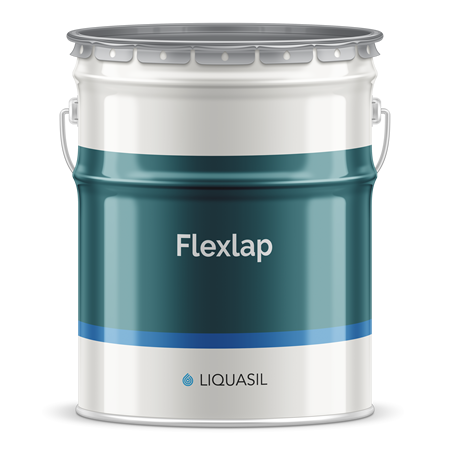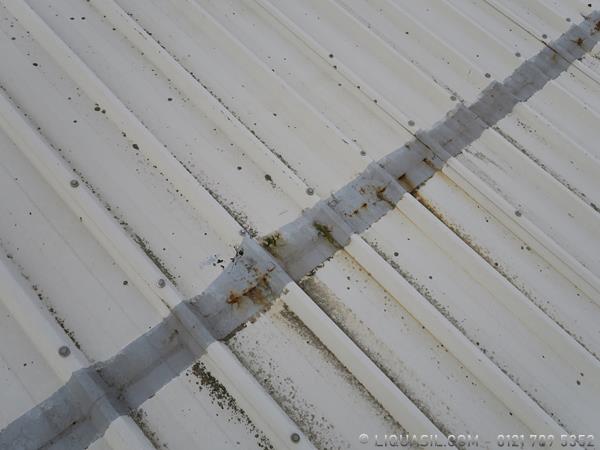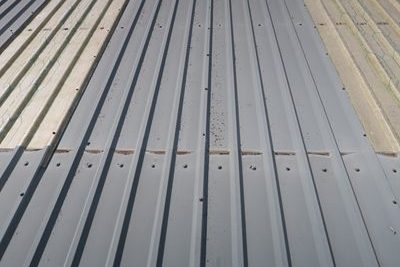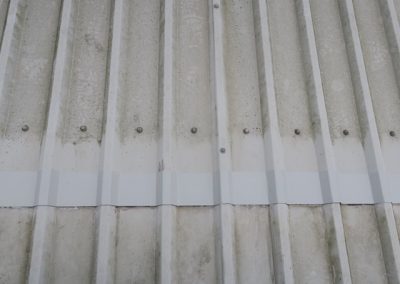
Cut Edge Corrosion Treatment By Liquasil
If you are a building surveyor, you already know that this is the main defect that you’ll find during your roof inspections.
But did you know that some treatments actually cause a latent defect?
Our stand-alone treatment for cut edge corrosion is called Flexlap and was the first in the UK to earn BBA approval.
It pairs a marine-grade epoxy primer with our unique self-levelling semi-gloss silicone coating.
This provides a specification-grade performance at a fraction of typical competitor cost.
Rather than hiding the cut edge defect, our anti-corrosion primer prevents further rusting of the substrate’s surface.
Our system is applied in a two-step process, starting with our corrosion primer to prevent, followed by a top coat for a UV resistant, protective finish.
Flexlap BBA Certificate
What Is Cut Edge Corrosion?
Cut edge corrosion is a defect commonly found on profiled steel roof systems. It is also typically the first defect identified by dilapidations surveyors during roof inspections. This is well understood within our team due to our background in building surveying.
How Roof Sheets Are Made
Roof sheets are produced from large coils of steel that are usually coated with a Plastisol finish before being formed into the profiled shapes used on roofs and cladding.
During manufacture, a protective zinc layer—known as the galvanisation layer—is applied to the bare steel. The sheets are then cut to size with guillotines, but this process leaves the edges exposed.
How Corrosion Begins on Metal Roofs
Soon after installation, the Plastisol coating starts to peel away from the steel and weathering quickly leads to rusting of the substrate.
For this reason, we recommend regular maintenance or roof inspections, because early detection of the defect reduces remediation cost.
If left untreated, corrosion becomes more advanced and the sheet ends may eventually rot through.
Rust and chemical corrosion can lead to roof leaks and internal damage.
Our roofing surveyors have seen many examples where corrosion has progressed beyond the fixing lines. This usually results in whole roof sheets having to be replaced rather than repaired.
It’s best to treat the cut edges as soon as the coating begins to peel, because early action reduces the cost of the repair.
Prompt treatment also helps ensure that costly dilapidations claims at the end of a commercial property lease are avoided or mitigated.
Causes & Signs of Edge Corrosion
Edge corrosion is usually caused by long-term weather and UV exposure.
Deterioration of unprotected cut edges can be accelerated in aggressive environments such as industrial or coastal areas.
When maintenance is poor and inspections infrequent, minor issues can develop into severe corrosion, resulting in significant structural damage to the roof.
We can demonstrate that sealing overlapping roof sheets with sealants and mastics can exacerbate cut edge corrosion.
We have many examples where sealant applied to overlapping roof sheet joints has trapped moisture between sheets.
The trapped moisture causes the metal roof sheets to rot from beneath and this becomes untreatable.
Edge Peel Of Factory Finish
A Better Cut Edge Corrosion Treatment
Liquasil was born from a building surveying practice.
Our team designed Flexlap to outperform traditional treatments. Instead of masking the issue with expensive sealants or coatings, Flexlap attacks the root cause.
Simplification is key and that results in lower costs.
Why Flexlap Stands Out
Contractors tell us that it’s simpler, cheaper, more effective and easier to apply than others.
The Flexlap Installation Process
- Prepare the affected surface to ST3 standard, which effectively means back to bare, non-shiny metal
- Apply SWT Primer to prepareed areas at wet film thickness of 125 microns
- Overcoat with Liquasil Flexlap
When cut edge corrosion is in the early stages, we recommend the joints on overlapping roof sheets at the mid-lap areas are not sealed.
Liquasil’s Flexlap can provide significant cost savings against most other cut edge corrosion treatment systems.
Example Cut Edge Corrosion Treatment Projects
Can An Existing Cut Edge Corrosion Treatment Be Over-Coated?
Where cut edges have been treated in the past, it is likely that a system was used that sealed the mid-lap joints.
For this reason, overcoating is not recommended. Inspections routinely show that such systems can trap moisture and cause underside corrosion.
This is a far more serious defect than the original cut edge corrosion.
Older treatments were also applied without an anti-corrosion primer, so corrosion is often still be present beneath the coating.
Because each manufacturer uses different technologies, best practice is for existing treatments to be removed.
This allows the surface to be fully assessed and prepared to achieve a durable repair.
Adhesion between different systems cannot be guaranteed, so starting again is the only reliable approach.
Overcoating existing treatments is usually a false economy.
Sealing Overlapping Roof Sheets Can Cause A Latent Defect
Here’s an image of a roof that has been treated with a cut edge corrosion that uses silicone to seal the overlapping roof sheets.
Rust has broken through the surface of the old treatment.
In your roof looks like this, the old treatment should be scraped back and the substrate examined.
We usually find that the rust breakthrough is due to water trapped behind the silicone sealant.
The sheet ends then become more corroded and often, the steel will be rotting away.
In severe cases, the bottom sheet of the overlap also becomes corroded, perforated or completely rotted, because the old treatment has effectively hidden the problem.
If you regularly look at roofs for dilapidations claims, make a point of looking closely at existing treatments, because your claims could be considerably higher than you think.
When in doubt, call one of our building surveyors for their recommendation, because sometimes, re-treatment is not the answer.

If You Really Have To Seal Overlapping Roof Sheets
How To Seal Overlapping Roof Sheets
There are occasions when it might be necessary to treat top and bottom sheets at the mid-laps and then seal them.
In such cases, we prefer to utilise our own HP Butyl Tape, a geo-textile faced, 20 year waterproofing tape that is far stronger than sealants.
This won’t necessarily stop or prevent underside corrosion, but it might help reduce the amount of moisture within the overlaps and help prevent underside corrosion.
Sealing laps is carried out at your own risk because water could always be present beneath, due to condensation and potential leaks from other areas in the roof.
But if you really prefer using a sealant we have a product called Lapsil that’s made just for this purpose, but again, it’s at your risk and down to your preference.
Strengthening The Mid-Lap Seal
When considering sealing overlapping metal roof sheets, the size of the gap between the upper and lower sheets needs to be considered.
When trafficked, the gap between overlapping roof sheets increases, but this effect can be reduced by stitching the sheets 100mm or so from the edge of the top sheet, ideally using stitcher screws, prior to treating the cut edge corrosion.
If rivets are used for this purpose, only stainless, sealed head rivets with an incorporated washer should be used.
Liquasil does not recommend the sealing of overlapping metal roof sheets in most cases.
Where sealing is deemed necessary, we strongly recommend that additional fixings or stitchers are incorporated to reduce inter-sheet movement due to foot traffic.
Sealing overlapping roof sheets may trap moisture or condensation, which can cause under-side corrosion of the roof sheets.
Careful consideration should therefore be given before sealing overlapping roof sheets, regardless of the sealing method.
Cleaning The Flexlap System
Flexlap is a soft silicone coating that in common with other cut edge corrosion treatments, is susceptible to environmental dirt pickup.
The unique composition of Flexlap makes it easier to clean than other cut edge corrosion treatments.
All that is required is a weak solution of washing up liquid and water. Simply wash the surface with a sponge or mop, rinsing regularly to avoid smearing dirt over adjacent surfaces.
Sometimes, underside corrosion will be present at mid-laps and this can result in unsightly rust staining being noticable below the treated areas. This is not a defect and will usually wash off with soap and water.
We do not recommend that jet washing equipment is used to clean Flexlap installations.
All installations should be examined annually for signs of surface damage and, if noted, the affected area should be cleaned, dried thoroughly and touched up with Flexlap.
Whilst Flexlap does not support fungal growth, it is possible for algae and soil to settle on the surface.
Washing will usually remove this, and Liquasil can provide an anti-fungicidal wash to help delay any recurrance.
Please note that Flexlap can only be touched with Liquasil products. Other products are not likely to adhere to the treated surface.
Roofing Contractors - Profit With Liquasil
Did you know that the supply of our BBA Approved cut edge corrosion treatment is restricted to experienced roofing and roof coating contractors that have completed our free product training?
Our systems are cheaper than the alternatives, yet out-perform them in so many ways.
Training is free. A small investment in time could easily be repaid countless times.
The Liquasil Guarantee
We want to make your roof coating decision as easy as possible, so Liquasil Ltd has a number of roof coating warranty options to support its 15-25 year product warranties.
On all qualifying full roof coating installations, gutter liner projects and cut edge corrosion works, insurance backed insurance policies may be provided via your approved installer at additional cost.
Product warranties are only available when Liquasil products are installed by Liquasil Approved Installers.*
Note: Cladcoat™ is excluded from warranty due to the wear and tear often experienced with industrial premises. It is a 10 year system and can be installed by any competent tradesperson.
We do not inspect Cladcoat™ projects as standard.
*Minimum project values apply for 25 year warranties
Call us today on 0121 709 5352 for assistance with your roof coating, gutter liner or cut edge corrosion treatment specification.



